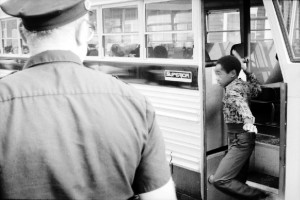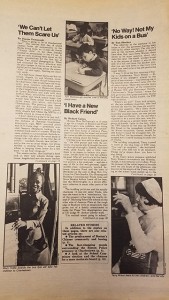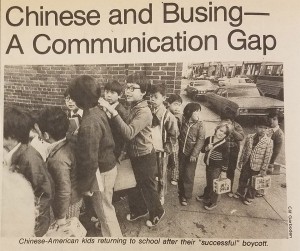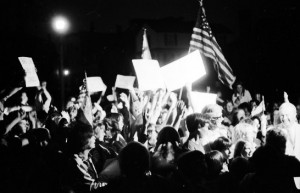The Media and Boston Public Schools Desegregation
The following is a series written by archivists, academics, activists, and educators making available primary source material, providing pedagogical support, and furthering the understanding of Boston Public School’s Desegregation history.
View all posts
When the court-ordered desegregation of the Boston Public School system led to controversial practice of busing in the 1970s, the local and national media covered it prolifically. Pictures of protests and school buses flanked by police officers made for eye-catching footage. But as Phase II of Busing approached in September of 1975, some residents felt they were being unfairly represented. Citizens of Charlestown complained that “the national media is always throwing up that we’re a violent people” as Newsweek reporters camped out to see “the second act of Boston’s national spectacle.” To some extent, the Boston Phoenix, did the same.[1] However, very few pictures of anti-busing protests appear in the paper. Those that do create an impact; one chilling example however shows a group of young white men standing around a burning effigy captioned with a racial slur published on September 16th.
The Boston Phoenix instead chose to focus on individuals, a piece on Judge Wendell Garrity, the federal judge who ordered the desegregation, ran on September 9, 1975 and an article written by Tom Sheehan, ran on September 16, 1975, titled “Three Families in the Midst of Busing” which profiled three families dealing with busing in different ways. The Hollis family, an African-American family being bused from Jamaica Plain to Charlestown, the McDonoughs, a white family being bused who supported the endeavor, and the Wrenns, a white family who opposed the decision. Even the articles regarding the protests focused on police officers and how they dealt with the protester’s attitudes towards them rather than the protesters themselves.
Alongside these articles Boston Phoenix readers looked into the faces of those taking part in the drama; school committee members, police officers, parents, and most all, the children. One of the most prolific of these photographers, capturing the faces of these players was Clif Garboden.
Clif Garboden began working for the Boston Phoenix as a freelancer in the late 1960s, eventually coming on the staff full-time. Garboden rose to the position of Senior Editor by the time he left the Boston Phoenix in 2009. During the turbulent years of the sixties and seventies, Garboden took his share of photographs of events but many times he focused on the individuals involved. While he was still a college student at Boston University, his photographs captured speakers, musicians, and professors for BU News. Even at that early point in his career, his photographs show the events occurring without losing the individuality of the people in the crowd.
His work during Busing is no different. The September 9th article on Judge Garrity includes not only a photograph by Garboden of the school committee in session which gives a sense of their work environment but the next page also provides close-ups of the members, their large name plagues dominating the foreground and their expressions betraying their thoughts and emotions of the subject matter. In the article “Three Families in the Midst of Busing”, Garboden photographed the pro-busing family the McDonoughs. While the photographers of the other two families chose to portray their subjects in the midst of action, Garboden’s shots are portraits, leaving it up to the reader to make their own judgement. This is not simply an editing choice, the Garboden Negative Collection, now available at Northeastern University’s Archives, shows that every shot he took was framed in this manner.
The Garboden Negative Collection offers a peak into the editorial practices of the Boston Phoenix. Garboden did take photographs of an anti-busing rally in Charleston but none of them ever made it to the paper. He took pictures of the reporting being done by the television news stations, possibly for an article regarding how the rest of the media was portraying the events. Instead, one of the most beautiful pictures he contributed to the Busing articles shows a lines of children, mostly Asian-American lined up at a bus stop in Chinatown accompanying an article by Nancy Pomerene. Although only one was published, the negatives show the amount of time Garboden took trying to preserve the sweet smiles of children who just wanted to go to school.
In the midst of the hullabaloo Garboden and the Boston Phoenix tried to highlight the stories of those overshadowed by the rest of the media and their collections allow those narratives to remain for future generations.
[1] Dumanoski, Dianne. “Charlestown – ‘My Town” – Braces for Busing.” The Boston Phoenix, September 02, 1975.



